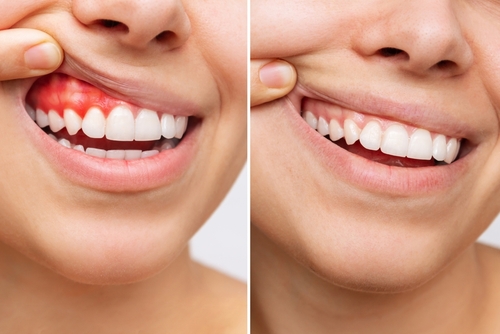Osseous Surgery for Gum Disease: Restoring Health and Confidence
Gum disease, also known as periodontal disease, is a common oral health concern, can lead to serious consequences if left untreated. However, our experienced San Diego, CA dentist, Dr. Vaheed Bayette provides hope in the form of osseous surgery, a procedure that offers a chance for renewal and a brighter smile.
If you’re experiencing periodontal disease, contact Dr. Bayette by giving our San Diego dental practice a call today at (619) 901-0708.
What Is Osseous Surgery?
Osseous surgery is a specialized dental procedure designed to treat advanced cases of periodontal disease. This surgery targets the bones and tissues supporting your teeth, aiming to remove diseased tissue and encourage regeneration.
Benefits of Osseous Surgery
Halting Disease Progression: Osseous surgery stops the advancement of gum disease, preventing further damage to the bone and tissues surrounding your teeth.
- Preserving Teeth: By removing infected tissue and reshaping the bone, osseous surgery can often save teeth that might otherwise be lost to gum disease.
- Improved Oral Health: This procedure leads to healthier gums and bones, reducing the risk of future infections and dental problems.
- Enhanced Aesthetic Appeal: Osseous surgery can restore a natural, healthy appearance to your gums and smile, boosting your confidence.
Candidacy for Osseous Surgery
Osseous surgery is typically recommended for individuals with advanced gum disease, characterized by deep periodontal pockets and significant bone loss around the teeth. Your San Diego dentist will evaluate your specific situation to determine if this periodontal treatment is the right option for you.
How the Procedure Works
 Anesthesia: You will receive local anesthesia to ensure you are comfortable throughout the procedure.
Anesthesia: You will receive local anesthesia to ensure you are comfortable throughout the procedure.
Accessing the Affected Area: Your skilled San Diego dentist will gently lift the gum tissue away from the teeth, providing access to the roots and bone.
Removing Diseased Tissue: Dr. Bayette will meticulously clean the root surfaces and remove any infected tissue.
Reshaping the Bone: If necessary, the bone may be reshaped to eliminate irregularities and encourage proper healing.
Closing the Incisions: The gum tissue is repositioned and stitched back in place, creating a snug fit around the teeth.
Frequently Asked Questions
During the procedure, you’ll be under local anesthesia, ensuring you feel no pain. Afterward, you may experience some discomfort, but this can typically be managed with over-the-counter pain relievers.
Recovery times vary, but most patients can return to their regular activities within a few days to a week. Full healing may take several weeks.
Yes, your dentist or periodontist will schedule follow-up appointments to monitor your progress and ensure optimal healing.
Yes, it can. Gum disease isn’t just about dental health; it affects your comfort, confidence, and quality of life. It can lead to pain, discomfort, and even tooth loss. Addressing it is a step towards a brighter, happier you.
Achieve a Healthy Smile Today
Choosing osseous surgery is a powerful step towards reclaiming your oral health and confidence. With its ability to halt disease progression, preserve teeth, and enhance your overall well-being, this procedure offers hope and renewal. Schedule a consultation with your San Diego, CA dentist to take a significant step towards a brighter, healthier smile. Embrace it with confidence!

 Halting Disease Progression
Halting Disease Progression Anesthesia
Anesthesia